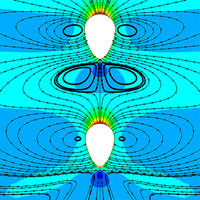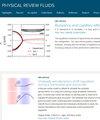Hydrodynamic interaction between coaxially rising bubbles in elasto-visco-plastic materials: Bubbles with a wide range of relative sizes
IF 2.5
3区 物理与天体物理
Q2 PHYSICS, FLUIDS & PLASMAS
引用次数: 0
Abstract
We consider the buoyancy-driven rise and interaction between two initially stationary and gravity-aligned bubbles of wide radii ratio and constant volume in an elasto-visco-plastic material, extending our previous work regarding bubbles of equal radii [Kordalis et al., Phys. Rev. Fluids 8, 083301 (2023)]. Primarily we consider a 0.1% aqueous Carbopol solution and model its rheology with the Saramito-Herschel-Bulkley constitutive model. Initially, we investigate the dynamics for a specific initial separation distance in a wide range of bubble radii, and we determine the conditions leading to three distinct patterns: bubble approach, bubble separation, and establishment of a constant distance between them. Specifically, when the leading bubble (LB) is smaller than the trailing bubble (TB), the bubbles approach each other due to the smaller buoyancy of the leading bubble. Strong attraction also occurs when the ratio of buoyant over viscous force of both bubbles is considerable. On the other hand, when the size of the TB is such that this ratio is moderate or small, the pattern is dictated by the size of the LB: A significantly larger LB compared to the trailing one causes separation of the pair. On the contrary, an only slightly larger LB may result in the bubbles rising with the same terminal velocity establishing a constant distance between them, the magnitude of which is mainly determined by the elastic response of the surrounding medium. The coupling of a negative wake behind the LB with a slight modification of the stresses exerted at its rear pole generates this dynamic equilibrium. The same equilibrium may be achieved by other specific pairs of bubble sizes for different initial distances of the pair if a critical initial distance is exceeded. Below this critical value, the bubbles approach each other. Finally, we construct maps of the three patterns with trailing bubble radius versus bubble radii ratio for different initial separation distances and material properties.

弹塑性材料中同轴上升气泡之间的流体动力学相互作用:相对尺寸范围较大的气泡
我们考虑了弹塑性材料中两个初始静止、重力对齐、半径比大且体积恒定的气泡在浮力驱动下的上升和相互作用,扩展了我们之前关于等半径气泡的研究[Kordalis 等人,Phys. Rev. Fluids 8, 083301 (2023)]。我们主要考虑 0.1% 的 Carbopol 水溶液,并使用 Saramito-Herschel-Bulkley 构成模型建立其流变模型。首先,我们研究了在广泛的气泡半径范围内特定初始分离距离的动力学,并确定了导致三种不同模式的条件:气泡接近、气泡分离和建立恒定的气泡间距。具体来说,当前导气泡(LB)小于后导气泡(TB)时,由于前导气泡的浮力较小,气泡会相互靠近。当两个气泡的浮力与粘性力之比相当大时,也会产生强大的吸引力。另一方面,当 TB 的大小使这一比率适中或较小时,模式则由 LB 的大小决定:与尾部气泡相比,LB 大得多的气泡会导致这对气泡分离。相反,如果 LB 稍大,则可能导致气泡以相同的末端速度上升,并在它们之间形成恒定的距离,其大小主要取决于周围介质的弹性响应。LB 后方的负向尾流与 LB 后极应力的轻微变化耦合,产生了这种动态平衡。如果超过临界初始距离,其他特定的气泡大小对在不同的初始距离下也可以达到相同的平衡。低于这个临界值,气泡就会相互接近。最后,我们构建了三种模式的拖尾气泡半径与不同初始分离距离和材料特性下的气泡半径比值图。
本文章由计算机程序翻译,如有差异,请以英文原文为准。
求助全文
约1分钟内获得全文
求助全文
来源期刊

Physical Review Fluids
Chemical Engineering-Fluid Flow and Transfer Processes
CiteScore
5.10
自引率
11.10%
发文量
488
期刊介绍:
Physical Review Fluids is APS’s newest online-only journal dedicated to publishing innovative research that will significantly advance the fundamental understanding of fluid dynamics. Physical Review Fluids expands the scope of the APS journals to include additional areas of fluid dynamics research, complements the existing Physical Review collection, and maintains the same quality and reputation that authors and subscribers expect from APS. The journal is published with the endorsement of the APS Division of Fluid Dynamics.
 求助内容:
求助内容: 应助结果提醒方式:
应助结果提醒方式:


